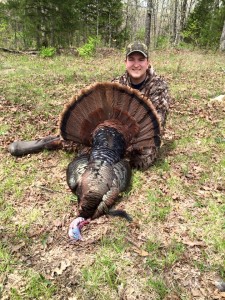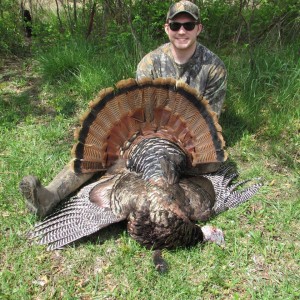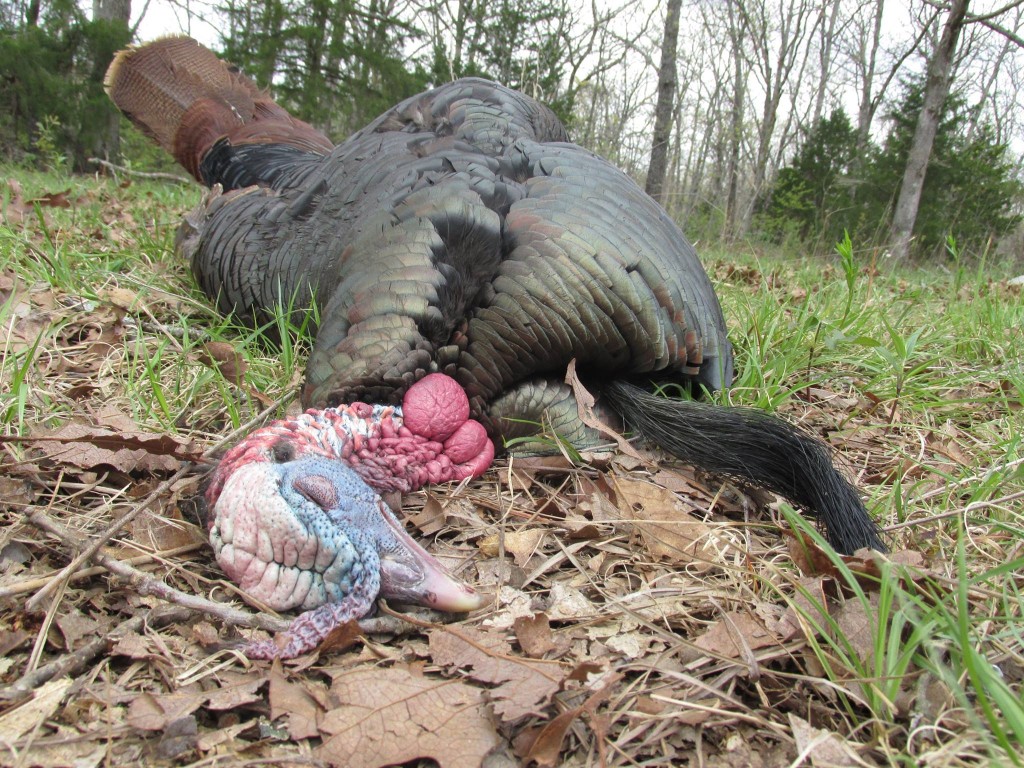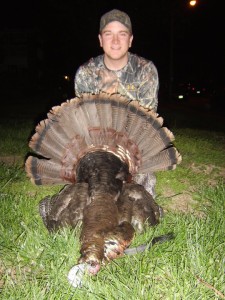Turkey Talk with Ryan Miloshewski
By Ryan Miloshewski
Greetings to all my fellow turkey hunters! Apologies for the delay on writing this piece; it’s been an exciting week and a half in the turkey woods! First, a successful trip to Kansas culminated in my taking of a bird, but most importantly calling in a bird for my good friend Ryan Haverstick, who was able to harvest his first turkey. I can honestly say I was just as excited for his first turkey as I was for mine—such an awesome feeling! Caleb Phillippi’s farm in Pomona, KS truly is a turkey mecca. I can’t wait to return soon!
After a great weekend spent chasing Kansas longbeards I headed to my farm in Rosebud, Missouri. I met my grandpa and we prepared for opening day, and soon fell asleep. Those Kansas turkeys wear you out! Opening day proved exciting, as I called in jakes and hens, but just couldn’t get a gobbler to succumb to my calling. Tuesday, however, ended in me taking my largest Missouri turkey to date. I had been calling all morning from a spot near the property line, hearing only wind and shrills of pileated woodpeckers as a response. Around noon I decided to slowly move toward camp, stopping to call along the way. I made it 100 yards before the gobble shattered the silence. He was close, but on the neighbor’s property. I immediately dropped to the ground, hid behind my full strut jake decoy, and let out a few soft yelps. He answered immediately and came in strutting the whole way. I shot him at 5 yards.

Tyler was able to take a bird on opening day in Missouri as well. Spring turkey season has been very special for both of us the past few years. We’ve been extremely fortunate to harvest a bird or two nearly every year, and have a great time doing it! Spring turkey season has an aura about it that encapsulates me. The spring sounds, Dogwood and Redbud blooms, morels, fishing, and the chess match against Mr. Tom all make this time of year special.

Tactics
Toms are breeding hens, and hens are allowing it to happen. It’s the turkey hunter’s version of “lockdown” during the whitetail rut. However, since Toms are much more vocal when lonely, taking a bird is very possible. Henned up is a term that is used to describe this time of year. Toms are roosting with hens, flying down, strutting for them, and then breeding. The hens are dictating the movement patterns for much of the day. But, once the morning hens leave the tom around mid-morning (which is very likely) the boys start looking for companionship elsewhere. This is where you capitalize.
Listen for a tom gobbling between 10:00 am and 1:00 pm (in Missouri) or even later in other states where all day hunting is allowed. Glass fields for a lone tom or group of toms. The key is to find toms without hens and set up on them. If you sound like a hen, chances are they will be very interested and come into range. Now, I’ve seen it happen where they come running in with abandon, and I’ve seen them slowly move in. Most of the time they come running, and it is a quick, exciting way to seal the deal on a bird. I shot my turkey eight minutes from when I first heard him. Just take the temperature of the bird and call to his liking.
Until most of the hens are bred, which will send the toms into another gobbling peak and on the hunt for receptive hens, this should be your main tactic. In the morning, set up near the roost—I mean get in tight (within 50 yds) and stake a decoy or two out. Try and determine the path the birds take when they hit the ground, and be there waiting as they pass by. Calling the toms away is not impossible, and by all means give it hell, but this strategy will be more likely to work in the morning. Still keep scouting and constantly looking for turkey sign, and be ready to adapt! Turkeys are unpredictable and you have to be ready to change tactics and plans at a moment’s notice.

Random Thoughts
-Listen for the “who-cooks-for-you?” call of the Barred Owl in the early morning hours. Turkeys shock gobble at it a majority of the time.
-Missouri’s state tree is the Flowering Dogwood. Look for the white or pink blooms right now.
-Watch out for snakes this turkey season. As the weather warms up the reptiles leave their dens and start foraging.
-The dewlap of a turkey is thought to be used to keep the bird cool. The snood, caruncles, and wattles are the part of the tom’s head that change color from red, white and blue, depending on the turkey’s mood. White typically means sexual arousal and red means anger.
-A jake’s gobble is usually half a second shorter than a tom’s. If you hear a short gobble accompanied by immediate yelping, it’s most likely a jake or group of jakes.
-Busting a turkey off the roost in the pre-dawn darkness is not a fun experience.
-If you don’t hear gobbling in the morning, don’t give up on that spot if turkeys routinely roost in the area. The turkeys just might not feel like gobbling that day. The next day could be booming with gobbles.
-Always take a fishing rod and lures with you on a turkey hunt.
-Use the terrain as much as you can to move on turkeys. It allows you to move quickly without being spotted when you have time constraints or just want to get the job done.
Quote of the Week: “The turkey’s eyes are such that he can see a bumblebee turn a somersault on the verge of the horizon.”—Archibald Rutledge
Thanks for reading this week’s edition of Turkey Talk with Ryan Miloshewski. Be sure to follow along by subscribing and following the Mahoney Outdoors Facebook Page!



